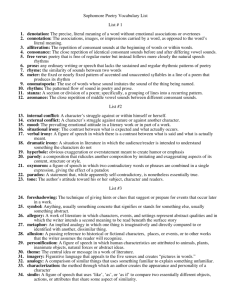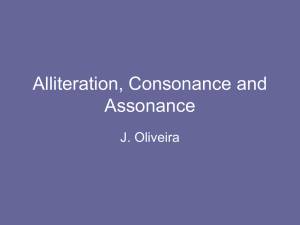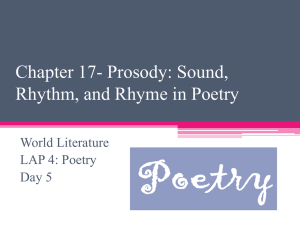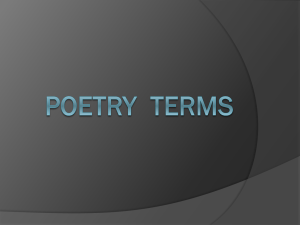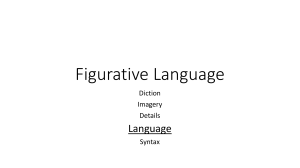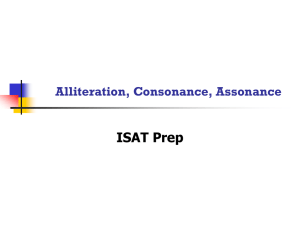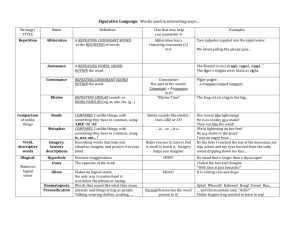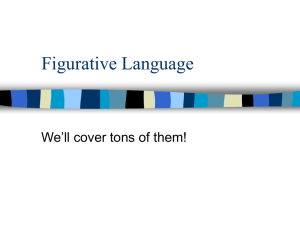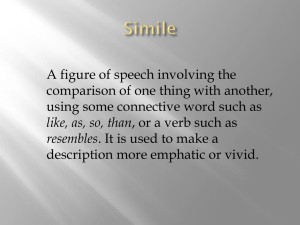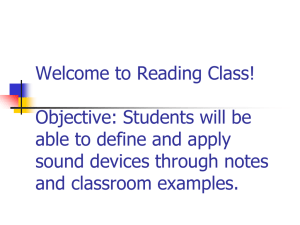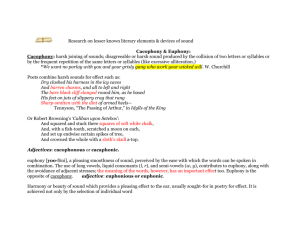Poetic Devices ALLITERATION: Alliteration, the repetition of initial
advertisement
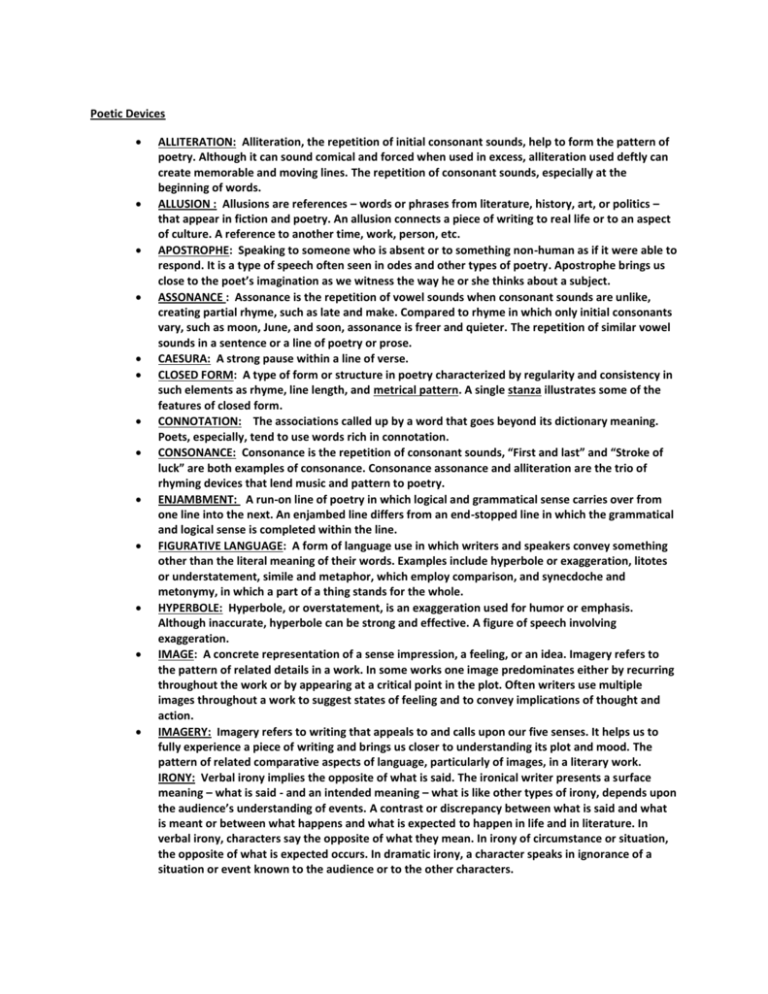
Poetic Devices ALLITERATION: Alliteration, the repetition of initial consonant sounds, help to form the pattern of poetry. Although it can sound comical and forced when used in excess, alliteration used deftly can create memorable and moving lines. The repetition of consonant sounds, especially at the beginning of words. ALLUSION : Allusions are references – words or phrases from literature, history, art, or politics – that appear in fiction and poetry. An allusion connects a piece of writing to real life or to an aspect of culture. A reference to another time, work, person, etc. APOSTROPHE: Speaking to someone who is absent or to something non-human as if it were able to respond. It is a type of speech often seen in odes and other types of poetry. Apostrophe brings us close to the poet’s imagination as we witness the way he or she thinks about a subject. ASSONANCE : Assonance is the repetition of vowel sounds when consonant sounds are unlike, creating partial rhyme, such as late and make. Compared to rhyme in which only initial consonants vary, such as moon, June, and soon, assonance is freer and quieter. The repetition of similar vowel sounds in a sentence or a line of poetry or prose. CAESURA: A strong pause within a line of verse. CLOSED FORM: A type of form or structure in poetry characterized by regularity and consistency in such elements as rhyme, line length, and metrical pattern. A single stanza illustrates some of the features of closed form. CONNOTATION: The associations called up by a word that goes beyond its dictionary meaning. Poets, especially, tend to use words rich in connotation. CONSONANCE: Consonance is the repetition of consonant sounds, “First and last” and “Stroke of luck” are both examples of consonance. Consonance assonance and alliteration are the trio of rhyming devices that lend music and pattern to poetry. ENJAMBMENT: A run-on line of poetry in which logical and grammatical sense carries over from one line into the next. An enjambed line differs from an end-stopped line in which the grammatical and logical sense is completed within the line. FIGURATIVE LANGUAGE: A form of language use in which writers and speakers convey something other than the literal meaning of their words. Examples include hyperbole or exaggeration, litotes or understatement, simile and metaphor, which employ comparison, and synecdoche and metonymy, in which a part of a thing stands for the whole. HYPERBOLE: Hyperbole, or overstatement, is an exaggeration used for humor or emphasis. Although inaccurate, hyperbole can be strong and effective. A figure of speech involving exaggeration. IMAGE: A concrete representation of a sense impression, a feeling, or an idea. Imagery refers to the pattern of related details in a work. In some works one image predominates either by recurring throughout the work or by appearing at a critical point in the plot. Often writers use multiple images throughout a work to suggest states of feeling and to convey implications of thought and action. IMAGERY: Imagery refers to writing that appeals to and calls upon our five senses. It helps us to fully experience a piece of writing and brings us closer to understanding its plot and mood. The pattern of related comparative aspects of language, particularly of images, in a literary work. IRONY: Verbal irony implies the opposite of what is said. The ironical writer presents a surface meaning – what is said - and an intended meaning – what is like other types of irony, depends upon the audience’s understanding of events. A contrast or discrepancy between what is said and what is meant or between what happens and what is expected to happen in life and in literature. In verbal irony, characters say the opposite of what they mean. In irony of circumstance or situation, the opposite of what is expected occurs. In dramatic irony, a character speaks in ignorance of a situation or event known to the audience or to the other characters. METAPHOR: A metaphor is an implied comparison between two unlike things. It does not use “like” or “as”. While a simile states that it is a comparison, a metaphor substitutes a new idea for the original and is often direct and strong. Metaphor is one of the most important of literary uses of language. ONOMATOPEIA: Onomatopoeia refers to words that sound like what they mean. Buzz sounds like a fly swooping toward your ear, and woof is the noise we hear when a dog barks. Onomatopoeia can also be used for non-animal noises, such as swish, whoosh, screech, and sizzle. The rhythm of a poem can also be a kind of onomatopoeia if it sounds like the thing it describes. The use of words to imitate the sounds they describe. Words such as buzz and crack are onomatopoetic. PARADOX : A paradox is a statement that seems to contradict itself but actually makes sense. A paradox often suggests a situation that appears impossible but that, in the context of a poem or story, can work. PERSONIFICATION: Personification is the giving of human characteristics to an animal, an object, or an idea. Because we are so familiar with human movements, feelings, and states of mind, personification helps us to precisely imagine the thing or concept described. The writer is giving inanimate objects or abstract concepts animate or living qualities. POINT OF VIEW: Point-of-view - The author's point-of-view concentrates on the vantage point of the speaker, or "teller", of the story or poem. The angle of vision from which a poem is narrated. A work's point of view can be: first person, in which the narrator is a character or an observer, respectively; objective, in which the narrator knows or appears to know no more than the reader; omniscient, in which the narrator knows everything about the characters; and limited omniscient, which allows the narrator to know some things about the characters but not everything o 1st person: the speaker is a character in the story or poem and tells it from his/her perspective (uses "I") o 3rd person limited: the speaker is not part of the story, but tells about the other characters but limits information about what one character sees and feels. o 3rd person omniscient: the speaker is not part of the story, but is able to "know" and describe what all characters are thinking. REPETTION: the repeating of words, phrases, lines, or stanzas. RHYME: The matching of final vowel or consonant sounds in two or more words. RHYTHM: The recurrence of accent or stress in lines of verse. SIMILIE : An obvious comparison between two unlike things, a simile is easy to spot because it is always prefaced by ‘”like,” “as,” “similar to,” “resembles,” or “as if.” A figure of speech involving a comparison between unlike things using like, as, or as though SYNTAX: The grammatical order of words in a sentence or line of verse or dialogue. The organization of words and phrases and clauses in sentences of prose, verse, and dialogue. UNDERSTATEMENT: A figure of speech in which a writer or speaker says less than what he or she means; the opposite of exaggeration. USE OF DIFFERENT FONTS AND SPACING: You can space out words, so they are all alone….so that they are all alone. Or you can run the words together without any spaces in between. You can also put key words on separate lines by themselves. Emphasize words by playing with boldface, italics, different sizes of letter, different colors, underlining,
